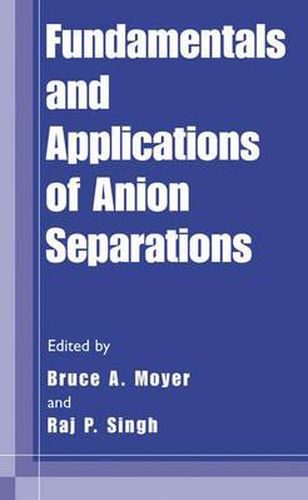Readings Newsletter
Become a Readings Member to make your shopping experience even easier.
Sign in or sign up for free!
You’re not far away from qualifying for FREE standard shipping within Australia
You’ve qualified for FREE standard shipping within Australia
The cart is loading…






This title is printed to order. This book may have been self-published. If so, we cannot guarantee the quality of the content. In the main most books will have gone through the editing process however some may not. We therefore suggest that you be aware of this before ordering this book. If in doubt check either the author or publisher’s details as we are unable to accept any returns unless they are faulty. Please contact us if you have any questions.
This book documents the proceedings of the symposium Fundamentals and Applications of Anion Separations held during American Chemical Society National Meeting in Chicago, Illinois, August 25-30, 200I. Nearly 40 papers devoted to discussions on anion separation related to fundamental research and applications were presented. The symposium, sponsored by Osram Sylvania, BetzDearbom, and the Separation Science & Technology Subdivision of the Industrial & Engineering Chemistry Division of the American Chemical Society was organized by Bruce A. Moyer, Chemical Sciences Division, Oak Ridge National Laboratory, P.O. Box 2008, Building. 4500S, Oak Ridge, TN 37831-6119, and Raj P. Singh, Chemicals and Powders R&D, Osram Sylvania, Chemical and Metallurgical Products Division, Towanda, PA 18848. It drew presenters from Australia, the Czech Republic, France, Germany, Japan, South Africa, Thailand, the United Kingdom, and the United States. Separations constitute an integral part of chemical industry. Chemical products typically originate in resources that must be concentrated and purified, chemically transformed, and subjected to fmal purification. Effluent streams from the processes must be treated to recycle reusable components and to remove environmentally harmful species. Some industrial processes are devoted to environmental cleanup after pollution has occurred. In addition, many analytical methods require a separation for preconcentration, or a separation may be an inherent part of the analysis itself. Micro separations occurring at membranes or interfaces are also related phenomena employed for ion sensing. Many species targeted for separation are naturally anionic. Although the standard separations techniques ofextraction, ion exchange, adsorption, precipitation, etc.
$9.00 standard shipping within Australia
FREE standard shipping within Australia for orders over $100.00
Express & International shipping calculated at checkout
This title is printed to order. This book may have been self-published. If so, we cannot guarantee the quality of the content. In the main most books will have gone through the editing process however some may not. We therefore suggest that you be aware of this before ordering this book. If in doubt check either the author or publisher’s details as we are unable to accept any returns unless they are faulty. Please contact us if you have any questions.
This book documents the proceedings of the symposium Fundamentals and Applications of Anion Separations held during American Chemical Society National Meeting in Chicago, Illinois, August 25-30, 200I. Nearly 40 papers devoted to discussions on anion separation related to fundamental research and applications were presented. The symposium, sponsored by Osram Sylvania, BetzDearbom, and the Separation Science & Technology Subdivision of the Industrial & Engineering Chemistry Division of the American Chemical Society was organized by Bruce A. Moyer, Chemical Sciences Division, Oak Ridge National Laboratory, P.O. Box 2008, Building. 4500S, Oak Ridge, TN 37831-6119, and Raj P. Singh, Chemicals and Powders R&D, Osram Sylvania, Chemical and Metallurgical Products Division, Towanda, PA 18848. It drew presenters from Australia, the Czech Republic, France, Germany, Japan, South Africa, Thailand, the United Kingdom, and the United States. Separations constitute an integral part of chemical industry. Chemical products typically originate in resources that must be concentrated and purified, chemically transformed, and subjected to fmal purification. Effluent streams from the processes must be treated to recycle reusable components and to remove environmentally harmful species. Some industrial processes are devoted to environmental cleanup after pollution has occurred. In addition, many analytical methods require a separation for preconcentration, or a separation may be an inherent part of the analysis itself. Micro separations occurring at membranes or interfaces are also related phenomena employed for ion sensing. Many species targeted for separation are naturally anionic. Although the standard separations techniques ofextraction, ion exchange, adsorption, precipitation, etc.